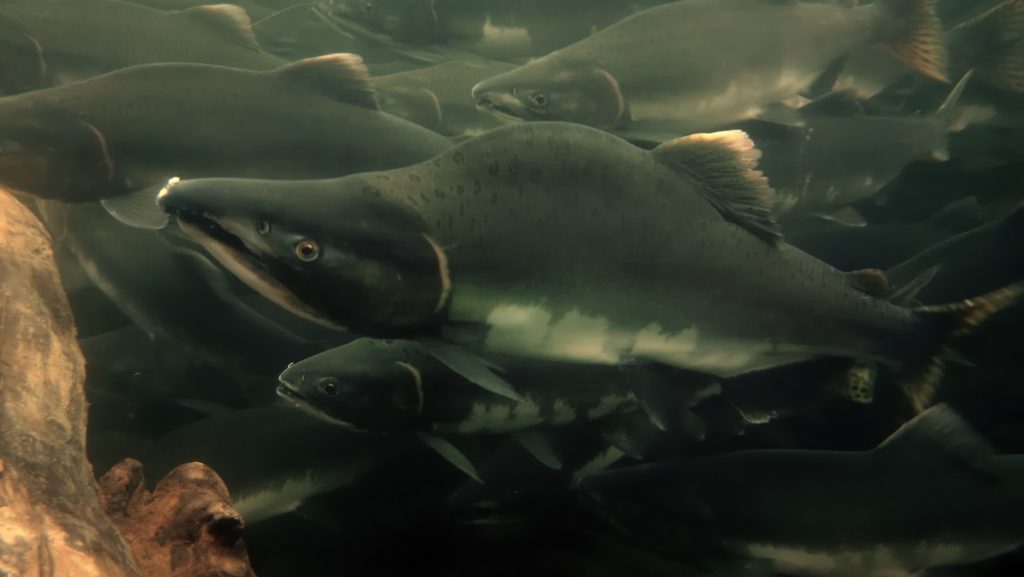In the aquaculture industry, one of the most important and most costly parts of raising fish, especially carnivorous fish, is providing them with the ideal feed for growth and health. Fish meal, which is essentially ground up smaller fish, is the perfect protein source for fish growth because it contains sufficient amounts of all the essential amino acids (proteins the body can’t make), vitamins, and minerals. However, fish meal is often more expensive than the alternatives, such as plant-based proteins. The price of fish meal can also be highly variable, especially during times like El Niño when anchovies, one of the main fish used to make fish meal, are less available. While plant-based proteins are less-expensive, carnivorous fish like salmon are not well-equipped to digest plant products due to their short intestine. Their intestine is comprised of just two short sections, the mid intestine and the distal (the furthest end) intestine. These conflicting priorities have led farmers to try and determine how much fish meal can be replaced with plant-based proteins without reducing growth or survival. Soy is used the most often in fish feed due to its high protein content and high levels of most essential amino acids.
One of the most severe health problems encountered when feeding fish soy has been named soybean meal-induced enteritis (SBMIE) by salmon researchers. Molecules in soy called saponins (and other unknown compounds to a lesser extent) cause irritation in the intestine of fish. Typically, a thin layer of mucus lines the inside of the intestine, but this irritation increases the thickness of the mucus layer which makes it difficult for nutrients to reach the lining of the intestine and be absorbed. Along the intestinal wall, there are thin projections of tissue (villae) that are present to increase the surface area available to absorb nutrients. As the amount of soy in the diet increases, these villae shrivel and shrink proportionately, further reducing nutrient absorption. This decrease in absorbed nutrients leads to decreased growth. The inflammation response from soy also increases gut permeability, which allows more pathogens into the bloodstream and makes fish more vulnerable to disease outbreaks.
Atlantic salmon have been cultured for decades, but now Pacific salmon are beginning to be cultured in greater numbers. Chinook (or king) salmon are grown mostly in Canada and New Zealand and Coho salmon are grown in Chile. Until now, it was unknown whether Pacific salmon suffer from soy induced enteritis like Atlantic salmon. Previous studies have shown that Chinook are very sensitive to soy products in their feed – typical soy levels for Atlantic salmon greatly reduce the feed intake and thus growth rate of Chinook salmon. Coho salmon and rainbow trout (members of the genus Oncorhynchus, like Chinook) are more accepting of soy in their feed but still eat significantly less when soy replaces more than 20% of the fish meal. This study is the first to investigate whether Pacific salmon also suffer from intestinal inflammation due to the soy compounds.
In this study, researchers gave feed composed of 20% soybean meal to Chinook and pink salmon, two species of Pacific salmon, and Atlantic salmon. Chinook showed the most severe enteritis symptoms, which was consistent with previous results of Chinook salmon being highly sensitive to soy. Atlantic salmon showed an intermediate level of response, and pink salmon showed only a very slight reaction that would not likely impact their growth or immune system.
The discovery that pink salmon show very little intestinal response to soy holds a lot of potential for improving other species. For example, if researchers find there are certain genes that enable pink salmon to tolerate soy, those genes (if present) could be bred for in other salmon species. This may allow salmon to become resistant to soy-induced enteritis, which would mean farmers could use more soy and less fishmeal. Using more soy would reduce feed costs and minimize reliance on wild-caught fish. Many high-protein plants that could be used as alternatives to fish meal also contain saponins, meaning they would have the same negative effect on most salmon species as soy. Solving the enteritis problem in salmon would also allow for many more kinds of plants to be used in their feed. Interestingly, herbivorous fish that are used to digesting plant matter, such as tilapia, and other cultured fish also show symptoms of enteritis when fed high levels of soy. Finding a species that doesn’t suffer from soy-induced enteritis such as pink salmon has the potential to help not only salmon, but many different species of fish.


